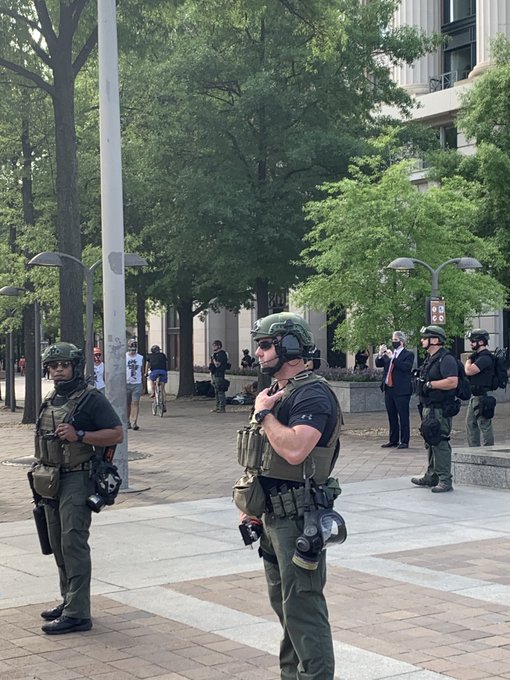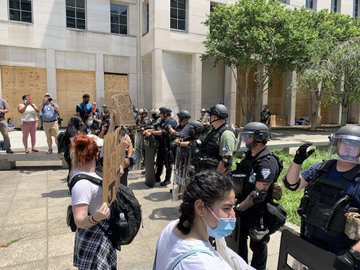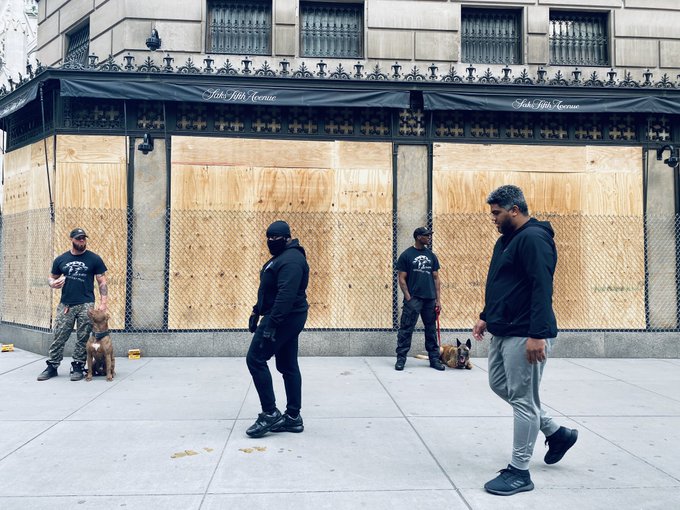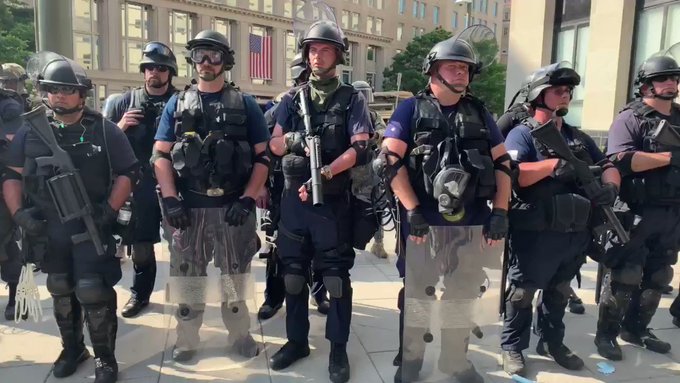But it wasn’t only components of the Defense Department that had been brought to the nation’s capital to help with the “domination” that President Trump sought to display in the wake of the turmoil. Washington residents have also been confronted with a number of other heavily armed law enforcement officers who share an unexpected characteristic: Neither their affiliation nor their personal identities are discernible.
On Tuesday, Mother Jones reporter Dan Friedan encountered these individuals, who gave no more specific identification than that they were associated with the Justice Department.
Asked who they’re with, these guys say only that they’re with “The Department of Justice.”
27.3K people are talking about thisNear the White House on Wednesday, MSNBC’s Garrett Haake had a similar encounter.
Back outside the White House. Today the perimeter has been pushed back another half block. Federal law enforcement of some kind, but they won’t identify themselves, and all insignias and name plates have been removed.
21.6K people are talking about thisSo did the New Republic’s Matt Ford. When he asked the armed men if they were associated with the Bureau of Prisons based on an acronym on their uniforms, Ford was simply told, “Maybe.”
As it turns out, each of these encounters was apparently with elements of the Bureau of Prisons, called to the region by Attorney General William P. Barr this week. Friedman confirmed with BOP that the men he encountered were with the agency; Haake’s Twitter followers picked out BOP insignia on their clothing.
“The idea that the federal government is putting law enforcement personnel on the line without appropriate designation of agency, name, etc. — that’s a direct contradiction of the oversight that they’ve been providing for many years to local police and demanding in all of their various monitorships and accreditation,” former New York City police commissioner William Bratton said in a phone interview with The Washington Post on Wednesday.
The prospect of government agencies involved in policing the city seeking to obscure their identities, Bratton said, was “very concerning.”
The vagueness of their identity and their disinterest in identifying themselves introduce specific challenges and risks, as former Army officer and FBI special agent Clint Watts explained in a phone interview with The Post.
For one thing, Watts pointed out, a civilian might refuse to respond to an order from a law enforcement official who doesn’t identify themselves in that way.
“If I go out and I pull out a gun and I say, ‘Freeze,’ and they say why, I would have to say, ‘I’m an FBI agent’ or law enforcement officer or whatever,” he said, “because otherwise they would be totally in the right to defend themselves potentially.”
He imagined his own reaction if he was on the street in New York or Washington and an unidentified officer pushed him with a shield: His instinct would be to fight back.
The added danger, particularly given the influx of officials in the area, is that law enforcement officers wouldn’t recognize one another. Bratton noted that one reason for identifiers is that officers would be able to recognize one another. Riot helmets often have identifying numbers on their backs in part for that purpose.
Watts described an incident shortly after he began at the FBI when an undercover agent who’d drawn his weapon was killed by another bureau employee who confused him with the perpetrator. Introduce scores of officers without identification into a volatile scenario and it’s easy to see similar (if less deadly) mistakes being common.
Particularly given another component of the moment. It’s not uncommon for civilians to dress in paramilitary gear and show up at the protests, often doing so as self-appointed assistants to police and other law enforcement officials.
“You can have this weird thing where you have these militia group guys just dressed up in their gear, which they like to do anyway, show up and just start pushing protesters around,” Watts said. “And if you’re a protester, you don’t know if you have to respond to this person.”
Granting unidentifiable law enforcement officials the ability to engage with and confront protesters functionally allows any unidentifiable individual to more easily pretend to be law enforcement. It introduces an opportunity for those looking to take advantage of the situation to target protesters or to cause disruptions.
The problem extends further. Consider the security hired to defend Saks Fifth Avenue’s flagship store in Manhattan.
Saks Fifth Avenue hirer security guards with specially trained dogs to protect the premises tonight in wake of the looting at Macy’s.
134 people are talking about thisIt’s easy to envision a scenario in which protesters are confronted by other hired security and forced to determine in real time if they constitute an official arm of law enforcement or if they’re simply hired muscle. There are widely divergent ramifications for a protester’s potential responses to such confrontations, depending on who the other person is.
And there’s an overarching question here: Why? Why are these officers unwilling to identify themselves or their organization? There’s clearly some power dynamic at play, as demonstrated in the snide “maybe” Ford was offered. But it also inhibits accountability.
“If those officers engage in any type of misbehavior during the time that they are there representing the federal government, how are you to identify them?” Bratton said. “What is the need for anonymity in controlling crowd demonstrations?”
Such anonymity echoes the way in which enforcers in autocratic regimes have worked to avoid accountability. If you believe that you were unlawfully detained or assaulted by a law enforcement official, you can try to hold them to account. (Of course, the extent to which you’ll be able to do so is another question, one at the heart of the current protests.) But how do you hold someone accountable when you don’t know who they are or even who they work for?
Ruth Ben-Ghiat, a professor of history at New York University and an expert on authoritarianism, noted the lack of accountability introduced by the government of Chilean dictator Augusto Pinochet for the actions of loyalist forces.
“The government passed laws that allowed the service records of military men and police who had been involved in torture and abuses to be destroyed so that their records were swept clean,” she said. “Many authoritarian leaders issue amnesty that free service people, clean up their records so that their abuses are never known.”
The point isn’t necessarily that the lack of identification offered by the men in Washington is intended to facilitate abuse. It’s that it hampers accountability, intentionally or not, which itself makes abuse more likely to go unchecked. Officers of the law are accountable to the public, something that’s harder to achieve if you don’t know who they are.
What the current situation demands is clarity. Given the tension between law enforcement and the protesters and given the existence of those looking to amplify that tension either as cover for illegal looting or to commit vandalism against the state, it seems more important now than it normally is that the enforcement arm of the government be identified by agency and individually.
“The idea of having no identification whatsoever as to the agency that you belong to,” Bratton said, “is highly unusual and, from my perspective, not professional at all.”
Haake updated his assessment of the scene at the White House on Wednesday afternoon, reporting that the unidentified officers had been replaced by members of the National Guard, in uniforms including the D.C. flag.
But that didn’t last long.
5PM WHITE HOUSE — These are the unidentified DOJ officers holding the perimeter at 15th and H Streets.
They won’t tell the public to whom they report exactly…
It’s generating HUGE frustration here #GeorgeFloyd @WUSA9
To Make Police Accountable, End Qualified Immunity
In their preference for a policy that protects police, conservatives abandon their commitment to textualism and embrace pro-government judicial activism.
If you haven’t watched the video of (former) Minneapolis police officer Derek Chauvin killing George Floyd by jamming his knee into Floyd’s cervical spine for nearly nine minutes until he loses consciousness, you really should. And if you can’t understand why large swaths of urban America have been in flames these last few nights, do two more things: (1) instead of George Floyd, who you probably don’t know, imagine the person pinned under Chauvin’s knee—prone, handcuffed, unresisting, and begging for mercy—was someone you love; and (2) listen to conservative pundits dissecting Chauvin’s merciless assault on Floyd with all the sangfroid of a referee performing an instant replay review to see whether the runner’s knee was down when the ball came loose. No wonder it seems as though the country is coming apart at the seams.
In determining the relationship between government and governed, one of the most important decisions a society can make is how accountable those who wield official power must be to those against whom that power is wielded. Congress made a clear choice in that regard when it passed the Enforcement Act of 1871, which we now call “Section 1983” after its location in the U.S. Code. Simply put, Section 1983 creates a standard of strict liability by providing that state actors “shall be liable to the party injured” for “the deprivation of any rights.” Thus, if a police officer walks up to your house and peeks inside one of your windows without a warrant—a clear violation of your Fourth Amendment right against unreasonable searches—he is liable to you for the violation of that right.
But many conservatives do an odd thing: In their preference for a more forgiving policy that gives police and other government officials substantial leeway in the exercise of discretion, they abandon their stated commitment to textualism and embrace an “interpretation” of Section 1983 that is utterly divorced from its text. The vehicle for this conservative brand of what we might call “living statutory interpretivism” is the Supreme Court’s qualified immunity doctrine, which judicially amends Section 1983 to provide that the standard for liability will no longer be the deprivation of “any rights”—as Congress expressly provided—but rather the deprivation of any “clearly established” rights.
As documented in considerable detail on Cato’s Unlawful Shield website, those two words—“clearly established”—do an extraordinary amount of work in keeping meritorious cases out of court and ensuring that plaintiffs whose rights have been violated by police or other state actors will receive no recovery unless they can find a pre-existing case in the jurisdiction with nearly identical facts. But that is plainly not the statute that Congress wrote, nor is it the standard of accountability that Congress chose. Moreover, as Professor Will Baude demonstrates in his masterful article, “Is Qualified Immunity Unlawful?,” there is no credible textual or historical basis for the qualified immunity doctrine; it is a blatant act of pro-government judicial policymaking—activism, if you will—and nothing more.
So now back to the killing of George Floyd. Watching that horrific video, one cannot help but notice the look of utter complacency on the face of Derek Chauvin as he drives his knee into Floyd’s neck. There is no life-or-death struggle—indeed, no struggle at all; nor is there any evident anger or passion—there is simply the banality of a man wearing a badge, surrounded and supported by other men with badges, methodically squeezing the life out of another human being.
It is well known that prosecutors rarely bring criminal charges against police officers, and indeed it seems unlikely Chauvin would have been charged had his assault on George Floyd not been captured on a viral video. That means the only avenue of accountability for most victims of police misconduct is a civil rights lawsuit that they themselves can initiate without the largesse of some prosecutor or citizen review board. But the Supreme Court has largely gutted that remedy with a judicially confected gloss that transforms the legislatively chosen policy of strict liability into one of near-zero accountability.
Cities are burning, and many people are venting their rage—yet again—about how cavalier police have become with the use of force, including lethal force, against the very citizens they are sworn to protect. Those people are right to be angry, and they’d probably be even angrier if they understood that it was never supposed to be like this—that Congress specifically chose a system of robust government accountability that was repudiated and perverted by the Supreme Court.
This Monday we will find out whether the Court will take the unprecedented opportunity it now has to revisit qualified immunity. It will be particularly interesting to see which self-styled conservatives—on and off the Court—place their stated commitment to textualism and judicial deference above whatever personal preference they may have for continuing our half-century experiment in near-zero accountability for law enforcement.
Attorney General Sees Too Much Secrecy in Epstein Estate
The top prosecutor in the U.S. Virgin Islands says the estate needs to provide more detail about Jeffrey Epstein’s finances and is insisting on clauses that could protect others from wrongdoing.
Some of the same furtive techniques that Jeffrey Epstein employed in life are showing up in the litigation over dividing up the wealth he left behind when he died.
There are mysterious companies, lingering nondisclosure agreements and contractual clauses that some lawyers fear could protect anyone who took part in Mr. Epstein’s wrongdoing.
The estate’s lawyers say they have a plan to fairly distribute money to dozens of women who have accused Mr. Epstein of sexually abusing them as teenagers. But the attorney general of the U.S. Virgin Islands, where Mr. Epstein built a complex web of corporate entities, says Mr. Epstein’s money is still buying silence.
And in the middle is a fortune estimated at well over a half-billion dollars.
“We have a lot of concerns with respect to the transparency of the estate and its finances and the accounting of the estate,” the attorney general, Denise N. George, said in an interview last month.
Ms. George filed a civil forfeiture lawsuit against the estate in January, roughly five months after Mr. Epstein committed suicide while being held in federal custody in Manhattan after his arrest on sex trafficking charges. She said she sued to protect the interests of Mr. Epstein’s accusers and recoup some of the money that Mr. Epstein made during his two decades in the Virgin Islands.
The estate has insisted it is acting in the best interest of Mr. Epstein’s accusers. But it has also provided an incomplete accounting of his finances, according to records reviewed by The New York Times.
At least one business — IGO Company L.L.C., a corporate entity established by Mr. Epstein in December 2006 — was left out of the estate’s court filings. The company, which lists Mr. Epstein as its sole owner, was still active and in good standing as of Monday, according to a U.S. Virgin Islands government site.
Lawyers for the estate did not respond to a request for comment. The co-executors of the estate are Darren Indyke, a lawyer, and Richard Kahn, an accountant. Both men worked closely with Mr. Epstein for many years and were listed as officers for some of his businesses.
Much of the fighting between the estate and Ms. George’s office involves a plan to establish a victims’ compensation fund, which would allow accusers to receive payments from the estate without a potentially costly court case. The estate’s representatives say the proposed fund — which would be set up with the help of the specialist who ran the compensation program for victims of the Sept. 11, 2001, terrorist attacks — would allow accusers to receive money quickly and privately.
But Ms. George said the estate wanted to attach too many strings to those payments.
On April 7, Ms. George’s office told the probate court handling Mr. Epstein’s will that she and the estate had reached an impasse over the estate’s demand that victims who take part in the fund agree to a broad release that would bar them from suing any party “whether they participated negligently or intentionally in wrongdoing themselves.”
To Ms. George, the estate’s conduct was a reminder of the legal maneuvers that surrounded Mr. Epstein’s guilty plea 12 years ago to soliciting prostitution from a minor in Florida. In 2007, federal prosecutors agreed to a wide-ranging nonprosecution agreement that covered Mr. Epstein’s named and unnamed co-conspirators. (A federal appeals court this month rejected a legal challenge brought by one of his victims to the agreement.)
Ms. George’s office said the estate now wanted to “secure similarly broad protection for Epstein’s compatriots-in-crime from their victims.”
Lawyers for the estate reject that argument. In their response, they said Ms. George had mischaracterized the situation and said two lawyers representing several accusers were ready to move forward with the fund. The estate’s lawyers contend the liability release is “modeled on releases employed in multiple voluntary compensation programs.” Its intent, they say, is to make sure a victim does not double-dip by getting compensation from the fund and then suing an individual affiliated with the estate who might be entitled to be legally reimbursed by the estate.
The particulars of how Mr. Epstein made his millions have long been a mystery, in particular after his 2008 conviction. Financial filings the estate has made so far have raised as many questions as they have answered.
In January, the estate filed a required report that, along with routine transactions to pay bills and other expenses, showed the estate had transferred more than $12 million to Southern Country International, a little-known private bank Mr. Epstein had established in 2014.
The magistrate judge overseeing the probate of the will, Carolyn Hermon-Purcell, questioned the estate’s lawyers about the transfers and asked for a fuller accounting. The estate has not yet filed an explanation; the territory’s courts have granted blanket extensions because of the coronavirus outbreak.
But according to four people familiar with the matter, the estate’s $12 million payment to the bank involved preparations for Mr. Epstein’s criminal case. Mr. Epstein used the bank to pay a $12 million retainer fee to the criminal defense attorney Reid Weingarten, according to the people, who spoke on the condition of anonymity because the matter has not been made public.
In mid-December, Mr. Weingarten’s law firm, Steptoe & Johnson, returned the unused portion of that retainer — roughly $11 million, according to the estate’s first quarterly filing. The next day the estate sent that money to the bank.
What happened to the money in Southern Country after that is not clear; the estate reported the bank had a year-end balance of just $500,000.
Southern Country is an unusual kind of bank: an international banking entity, which is limited to conducting business for customers overseas. Mr. Epstein was approved for his license in 2014, but the bank had not commenced doing business as of April 2018, according to a letter the bank sent to its regulator.
According to two people briefed on the matter, Mr. Epstein began to move money to Southern Country last spring after Deutsche Bank, his longtime bank, decided to sever all ties with him in response to a series of stories about Mr. Epstein by The Miami Herald.
Ms. George’s office is small compared with her mainland counterparts, and she has bulked up its resources by hiring a forensic accountant and outside lawyers with Motley Rice, a large plaintiffs’ litigation firm. But it has been active.
In recent weeks, Ms. George’s office sent a subpoena seeking bank records for Mr. Epstein’s businesses in the Virgin Islands, according to two people briefed on the matter. She also subpoenaed some records from the Virgin Islands Economic Development Authority, the government agency that granted lucrative tax benefits to Mr. Epstein’s companies, said Tracy Bhola, an authority lawyer.
According to one person familiar with the matter, Ms. George’s office has also made a demand for information from Mr. Epstein’s former girlfriend and business associate Ghislaine Maxwell, who recently filed a lawsuit against the estate asking it to cover her legal fees for any claims brought against her by his accusers.
Ms. George’s office has also reached out to some of Mr. Epstein’s former employees in the Virgin Islands. She said her office was trying to navigate around nondisclosure agreements that Mr. Epstein had signed with many of his them. She said the estate should commit to releasing the employees from those agreements.
“Just the existence of an N.D.A. casts a shadow or chilling effect on anyone speaking freely,” she said.
While many of Mr. Epstein’s companies — including IGO Company L.L.C. — continue to exist on paper, there is little left of their physical operations.
Those include Southern Trust, once Mr. Epstein’s main business venture, which generated $300 million in profits in just six years. Mr. Epstein had said it was a DNA research firm, although Ms. George said her office had found no evidence it engaged in that kind of work. Southern Trust alone is valued at $234 million, and the estate has yet to disclose where most of its assets are being held.
For months after his death, employees still showed up at the company’s office in the American Yacht Harbor club on St. Thomas. That stopped in late February, and by the start of last month the office doors were secured with a padlock.
Trump Supporters: Explain Away Anything
This pretty much sums it all up… sadly. Send help… I live in a red state!!! pic.twitter.com/XwDH5Pr1P7
— Samantha (@ohhaieverbody) April 26, 2020











